Fushimi Inari Hike: A Trail Guide to Kyoto’s Famous Shrine
8 min readIf you plan to visit the beautiful Fushimi Inari Taisha in Kyoto, you cannot miss out on its easy hiking trail, which leads you to the Mount Inari summit! With...
The post Fushimi Inari Hike: A Trail Guide to Kyoto’s Famous Shrine appeared first on Bucketlist Bri.
If you plan to visit the beautiful Fushimi Inari Taisha in Kyoto, you cannot miss out on its easy hiking trail, which leads you to the Mount Inari summit!
With its 10,000 vermillion Torii gates, Fushimi Inari is not just Kyoto’s most iconic Shinto shrine but one of Japan’s top attractions.
Not to mention, it is also the head of all Japan’s Inari shrines.
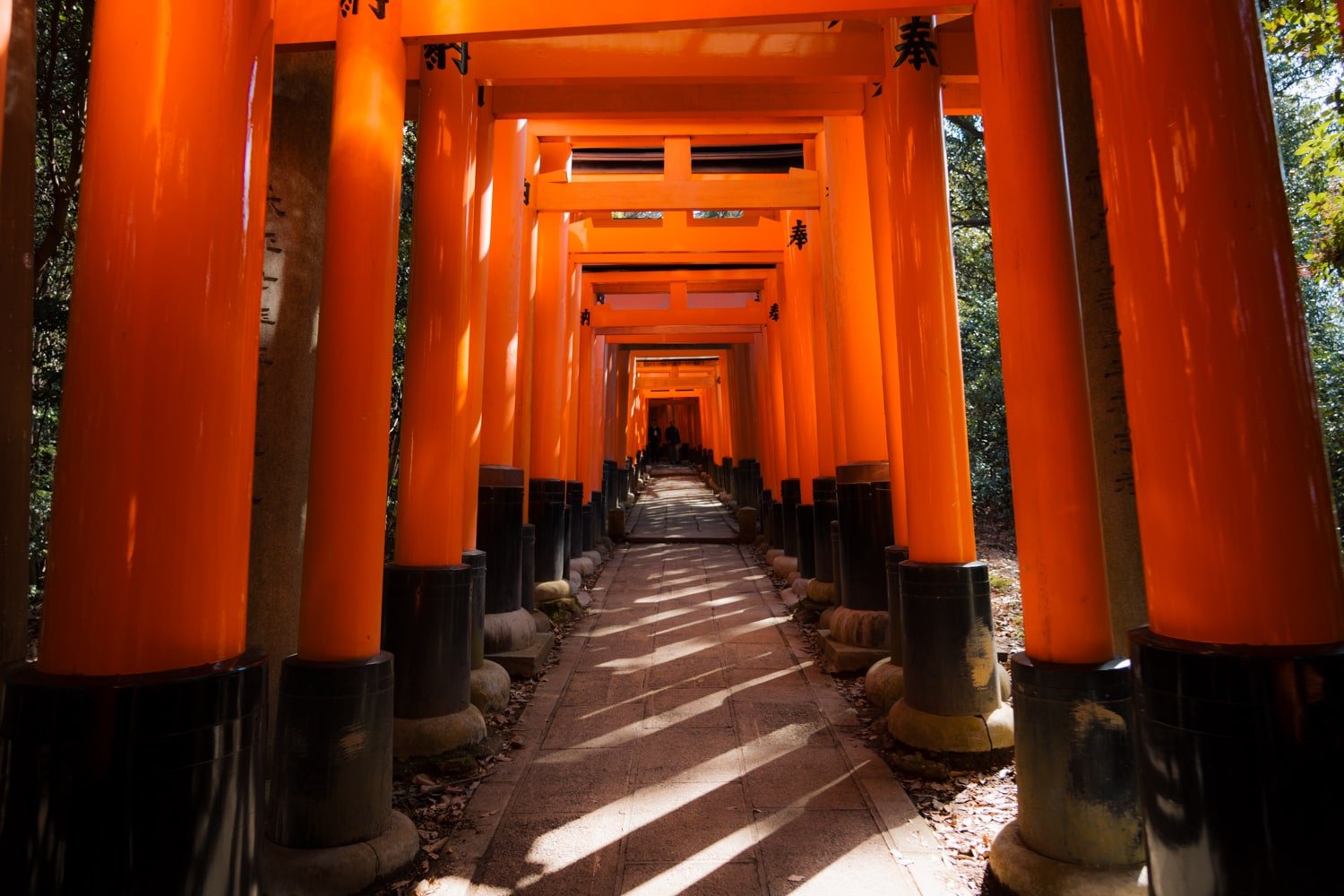
Disclaimer: This post may contain affiliate links which means I may earn a commission for bookings (at no extra cost to you). Thanks so much for your support!
However, that said, on my recent visit, I was quite surprised to see how relatively few visitors follow the Torii gates to the top of the mountain via the Fushimi Inari trail.
On my first visit to Kyoto, I skipped visiting Fushimi Inari because I had little time to enjoy the shrine.
On my second visit, I finally made it not only to the shrine grounds but to the Mt Inari summit (233m).
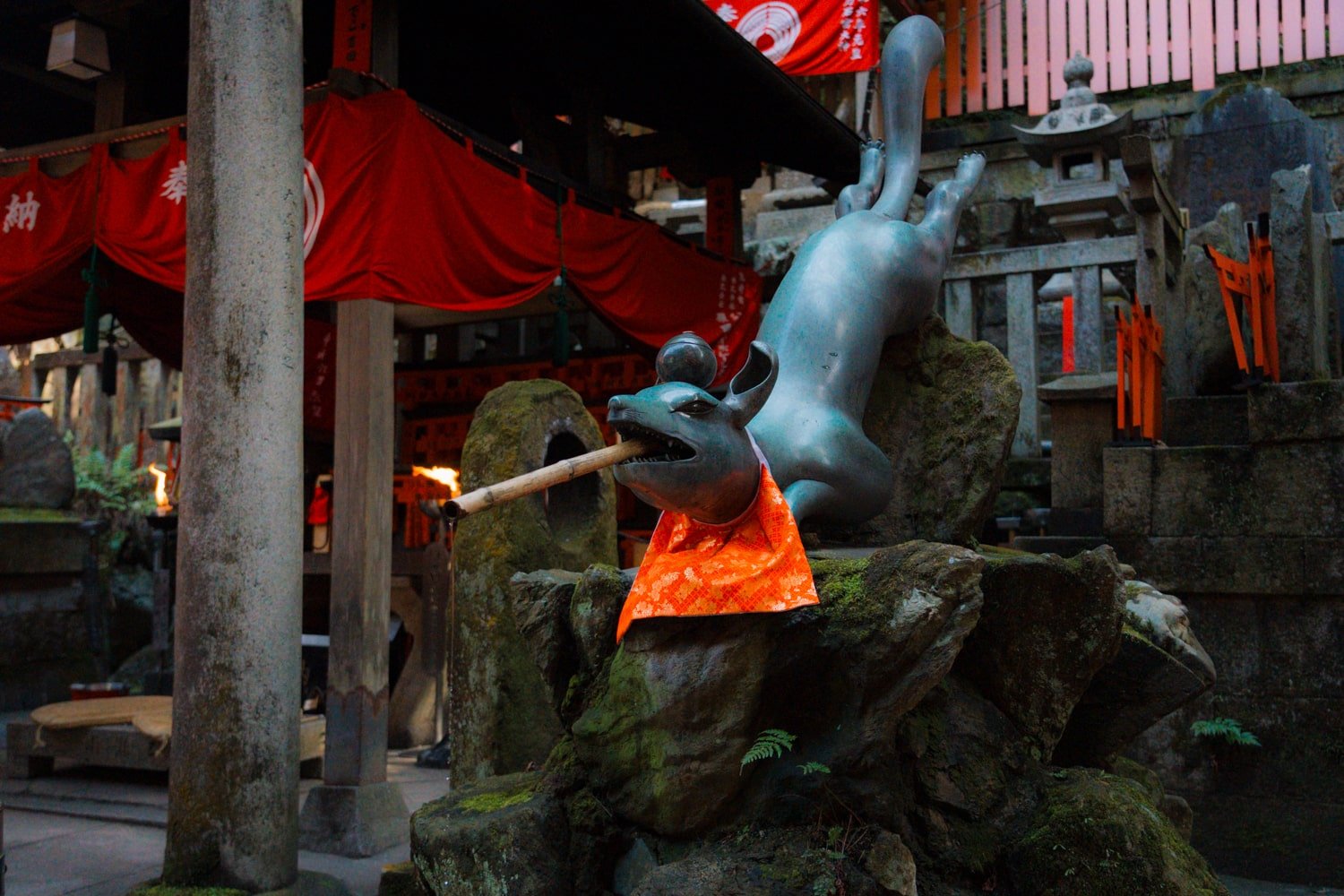
Even though Fushimi Inari Shrine’s main temple complexes are ancient and resplendent in their own right, I found the real treasure to be in meandering the mountain trail under its mystical Torii gates. 🦊
The further up I went, the fewer faces I saw. Until, at last, I found myself alone with the Inari Okami spirits.
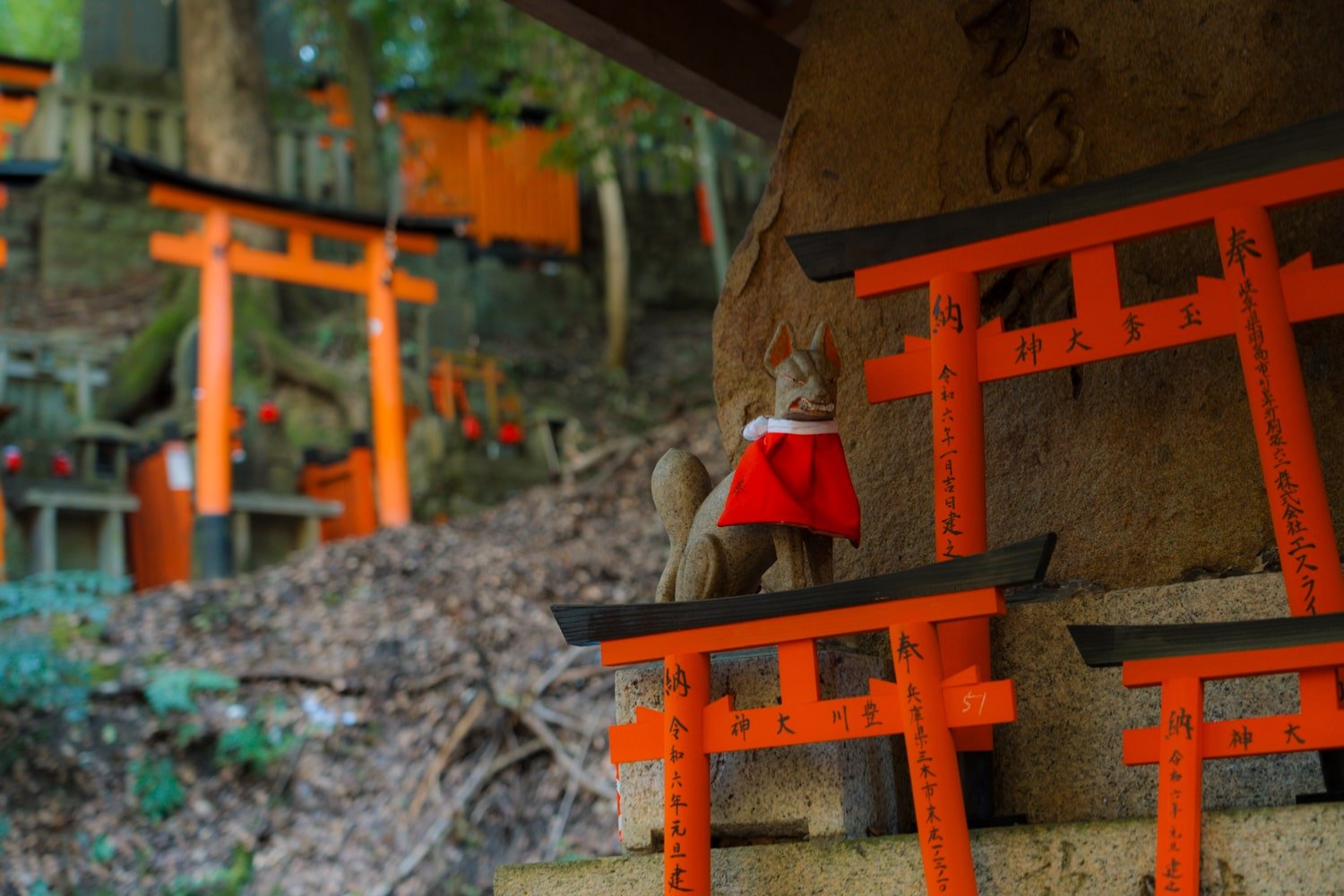
If you’re a nature lover and up for a mild and rewarding challenge to reach the summit of Mt. Inari, you must do the Fushimi Inari hike when visiting the shrine (a must-see in Kyoto).
Whether you enjoy nature and wish to explore Fushimi Inari more deeply—or just want to get an Instagram-worthy photo of the Torii gates with no one else around (hey, no judgment here)—read more below!
In this quick guide, I’ll detail how best to visit the Fushimi Inari Taisha and what to know about the hike.
show
Guide: Fushimi Inari Shrine Hike in Kyoto
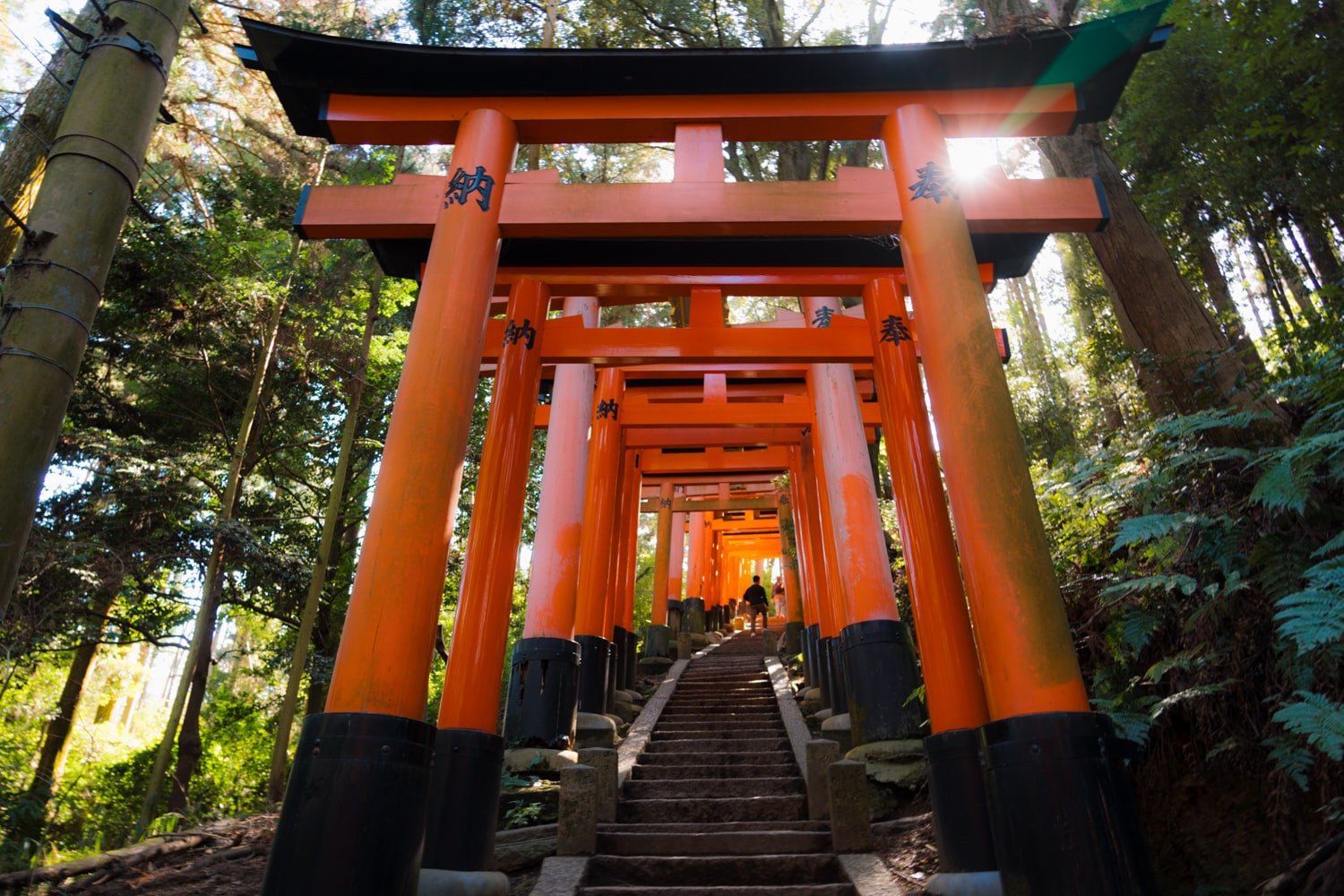
FAQs – Hiking Mount Inari (via Fushimi Shrine Trail)
Is the Fushimi Inari trail worth it?
For starters, you might be wondering… is the Fushimi Inari hike even worth it?
As hiking up to the summit and back will add to your time, you should decide before going whether or not you intend to do this full loop.
Understandably, if your time in Kyoto is limited, you may want to save space in your itinerary for other activities. After all, there is SO much to see and do in Kyoto!
But I do highly recommend taking the time to explore the Fushimi Inari shrine, including the trail up to Mt Inari summit.
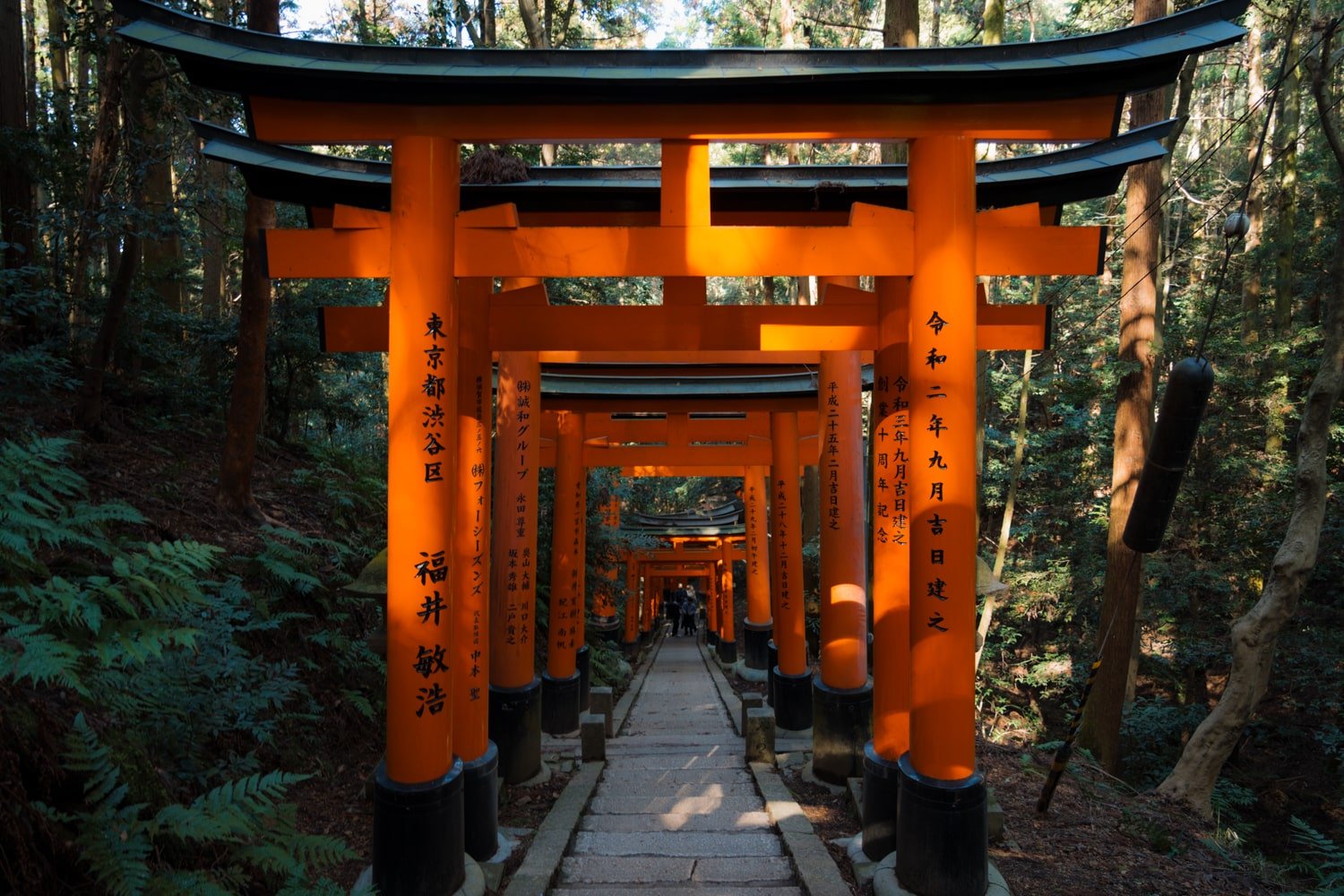
Not only will you get a better understanding and experience of the shrine, but you will also get to do so without the massive crowds—since most people skip out on doing the full loop.
How long does it take to walk the Fushimi Inari Shrine trail?
Visiting the shrine AND walking the Mt. Inari loop will take around 3 hours. Expect to spend an entire morning or afternoon at Fushimi Inari if you do the hike.
A white sign at the crossroads past the first lane of torii gates says the loop will take only 30 minutes. I am a fast walker/hiker, and although I did stop to take photos, there’s no way I would have been able to do that loop in under 30 minutes!
So keep that in mind as you set out to do this trail.
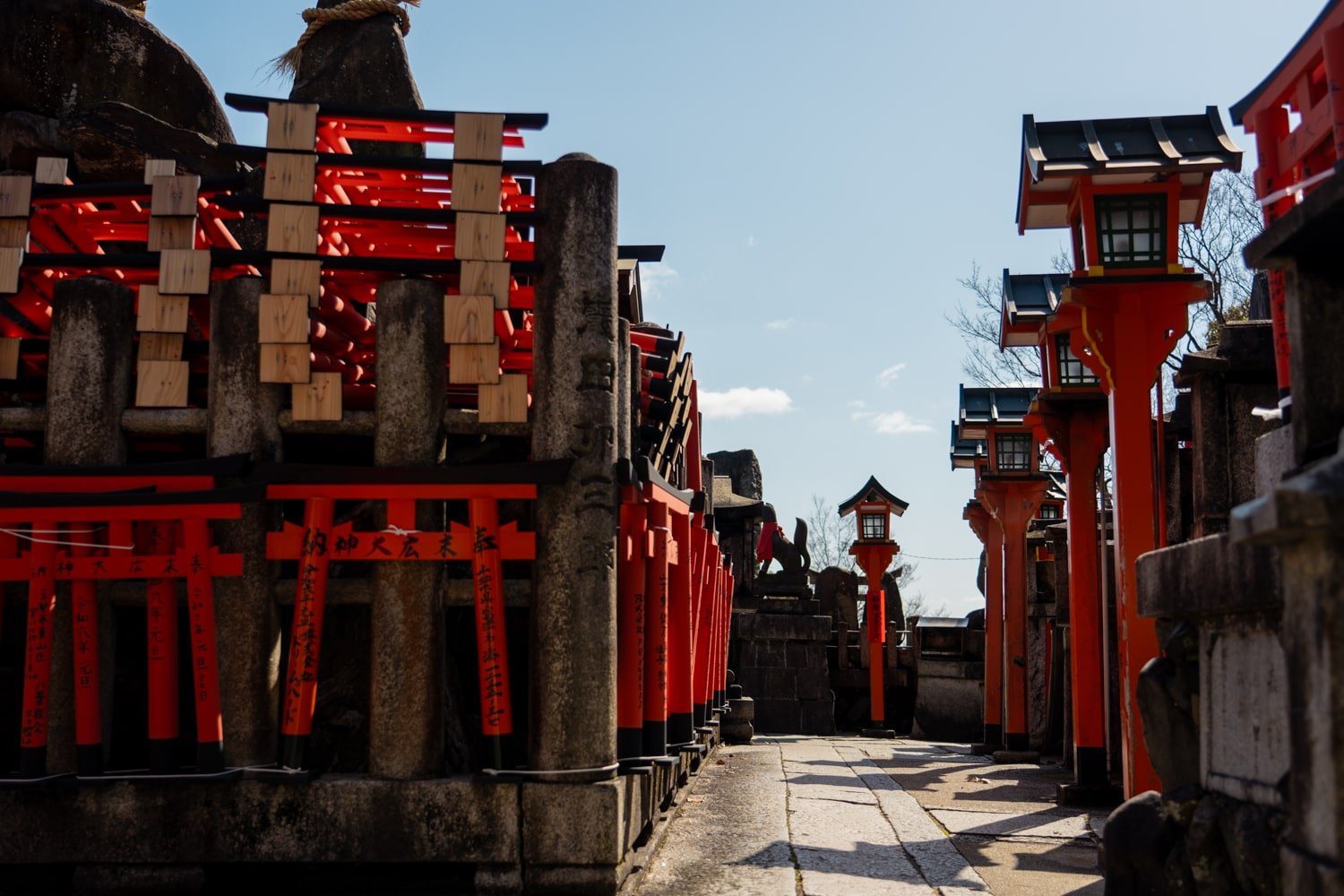
Do you need a guide to hike Mt. Inari?
No, you can hike to the Mt. Inari summit on your own. However, if you want an insider’s scoop into the history and symbolism of Shintoism, along with hidden nooks and places to see along the trail, you can take a Hidden Fushimi Inari Hiking Tour.
Read more below for my recommended DIY route!
Hiking Fushimi Inari Counterclockwise (Best Route)
With the red Torii gates and white fox decorations guiding the way, you will know you’ve arrived at your destination as soon as you leave the train at Fushimi-inari Station.
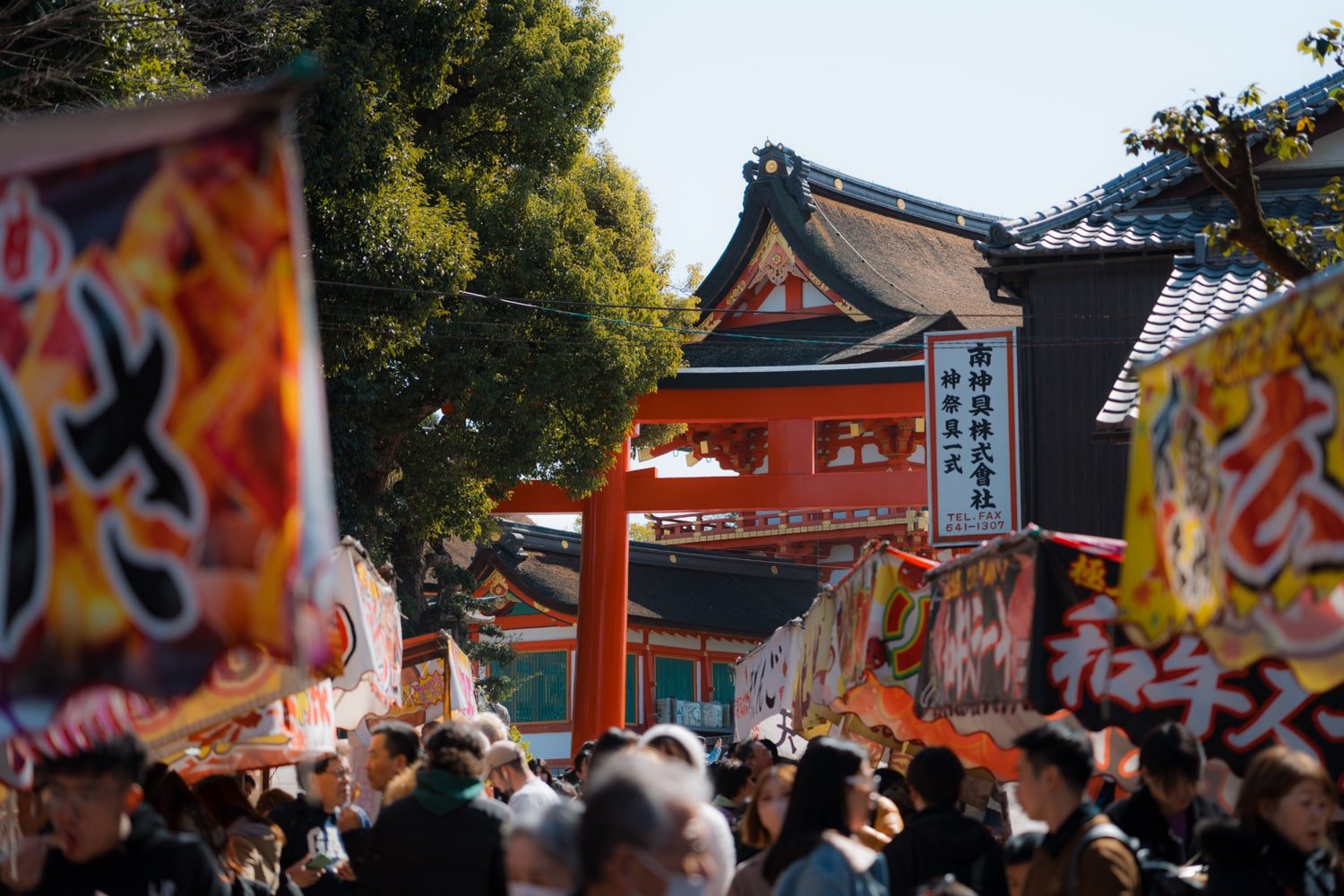
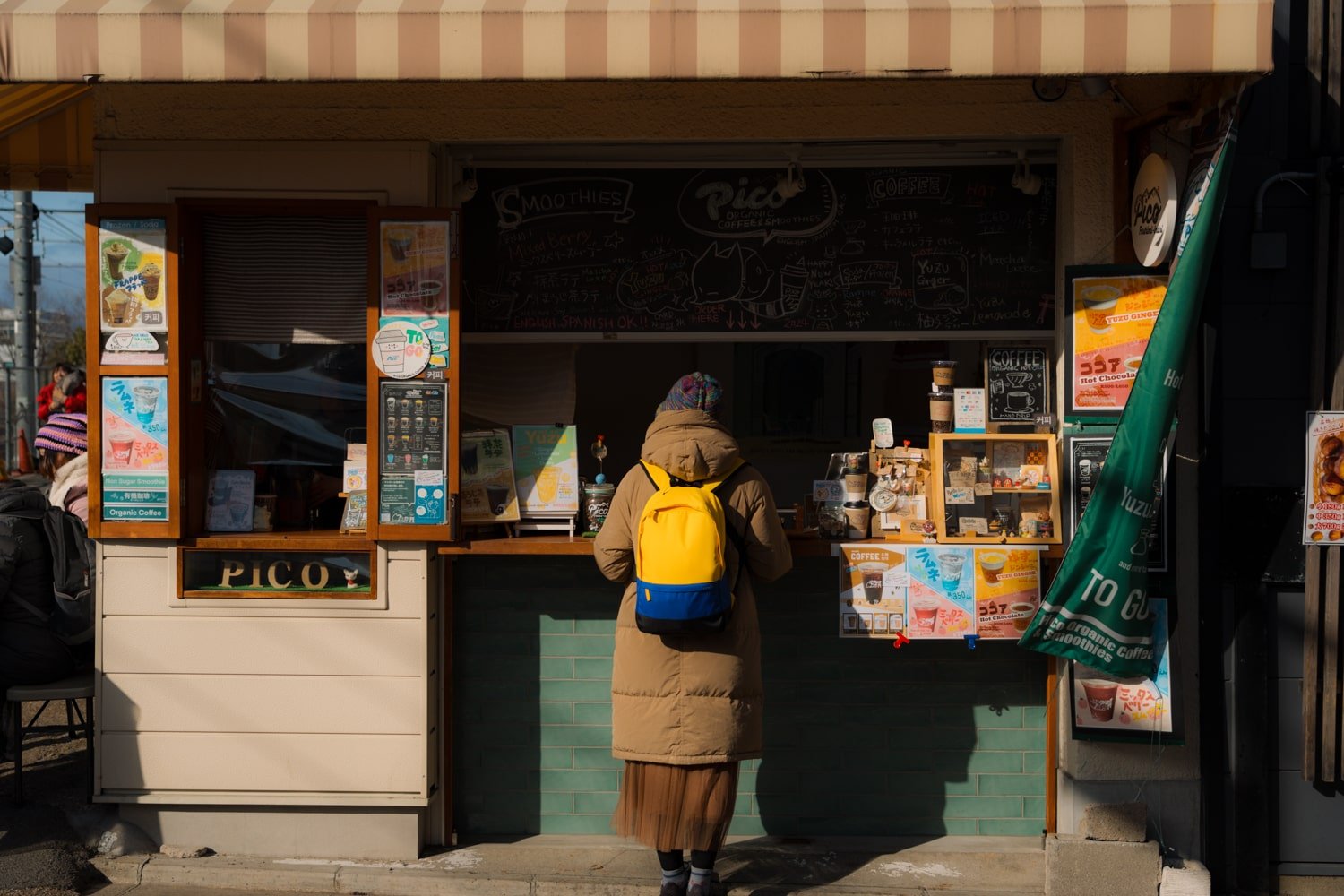
If you haven’t had the chance to grab breakfast or lunch, take advantage of the cafe and street food options lining the road leading up to the west-side entrance gate.
As you’ll see via the map immediately to your left, the Fushimi-inari shrine complex spans a lot of ground.
First, you can visit and pay your respects at the two-storied gate, main shrine, and worship hall.
I won’t divulge all the details of every shrine in this post (you can scan a QR code for descriptions during your visit), but rather share quick tips for the trail itself.
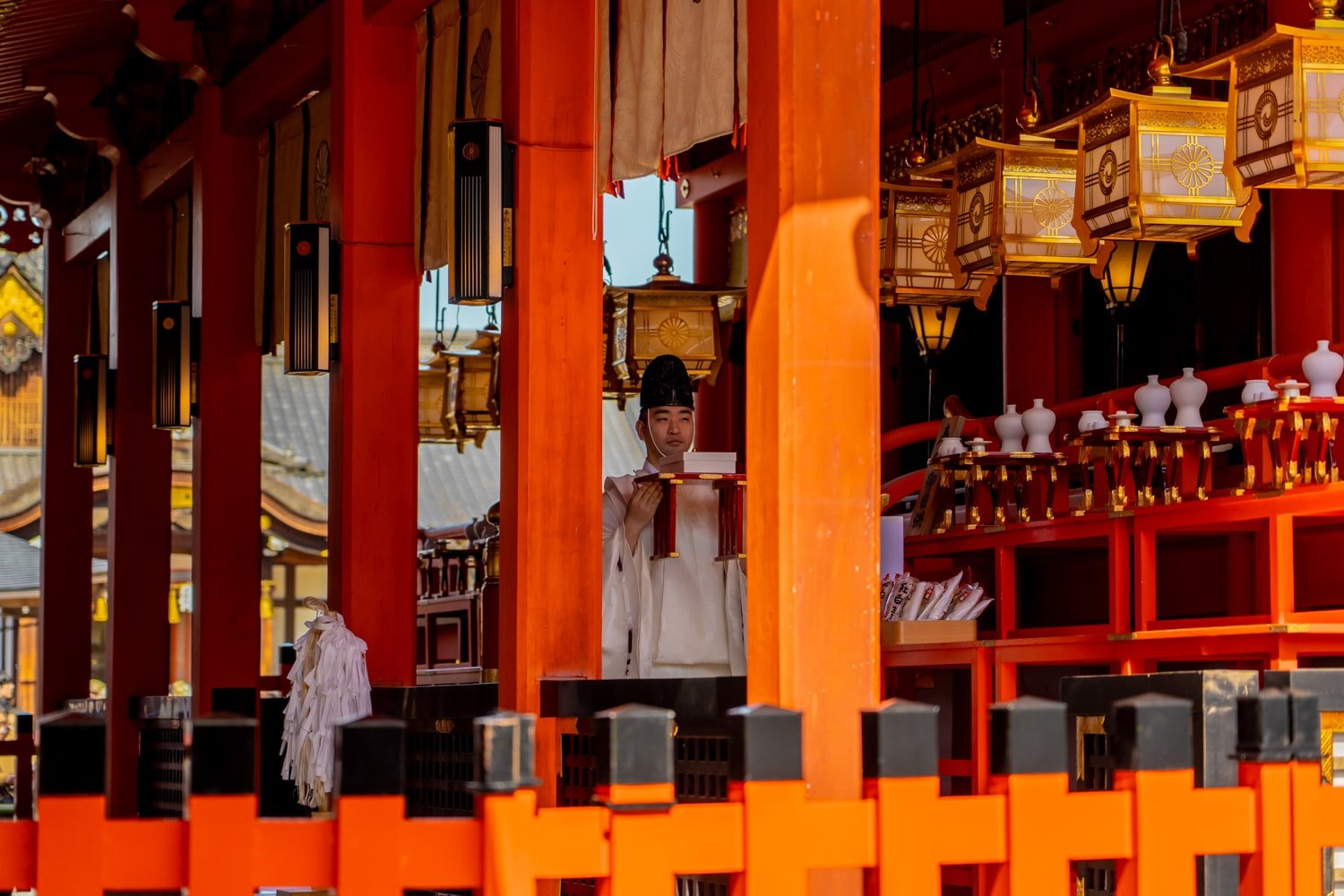
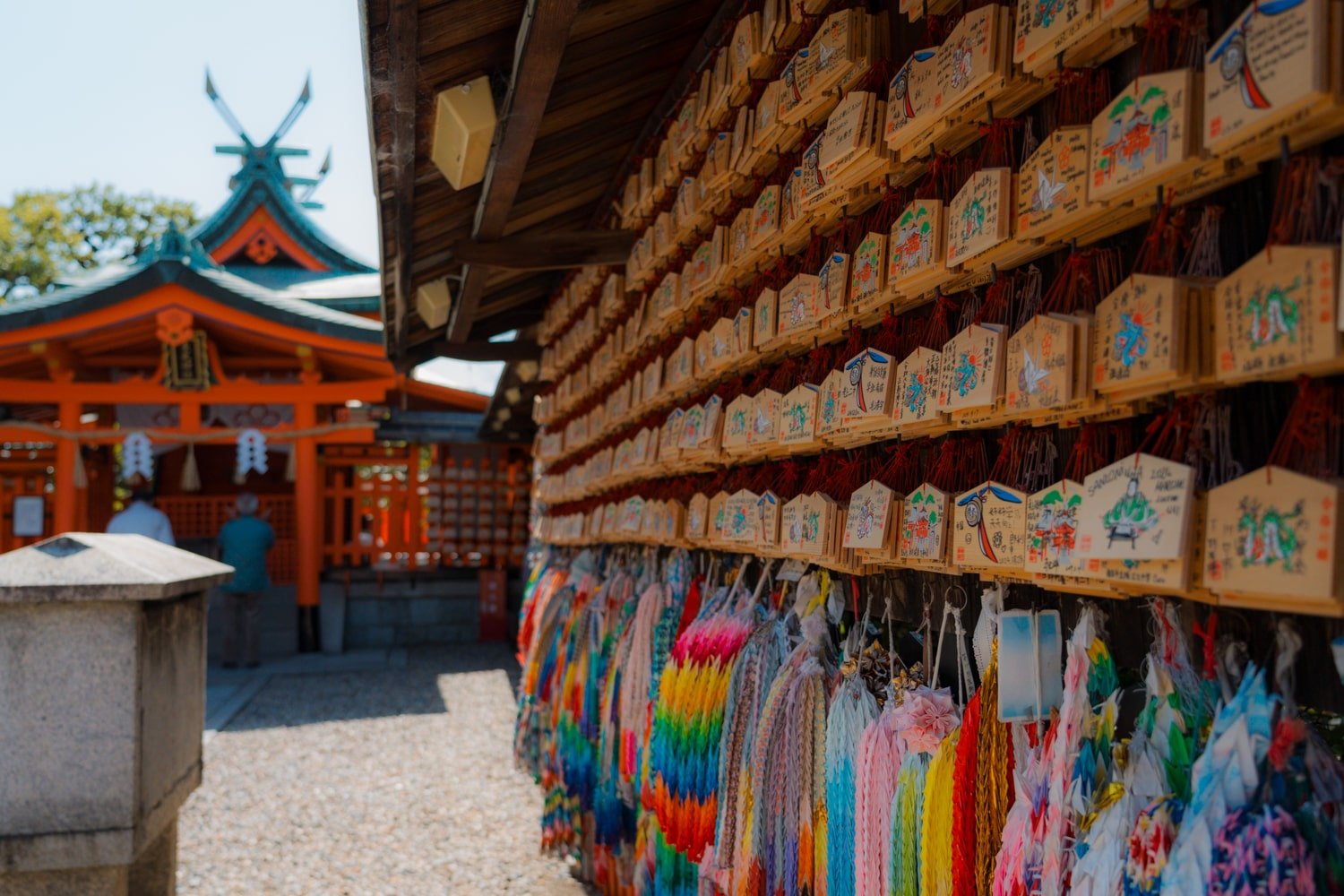
Follow the stairs up behind the shrine and stick right to the entrance of the famous Senbon Torii (1000 Torii gates).
Photo tip: As tempting as it might be to stop traffic flow to get a photograph with no one else in the shot (which will be nearly impossible if you go a minute after sunrise), don’t! Wait to take your photos further up the trail—there will be opportunities to take better compositions of the Torii gates later. 📸
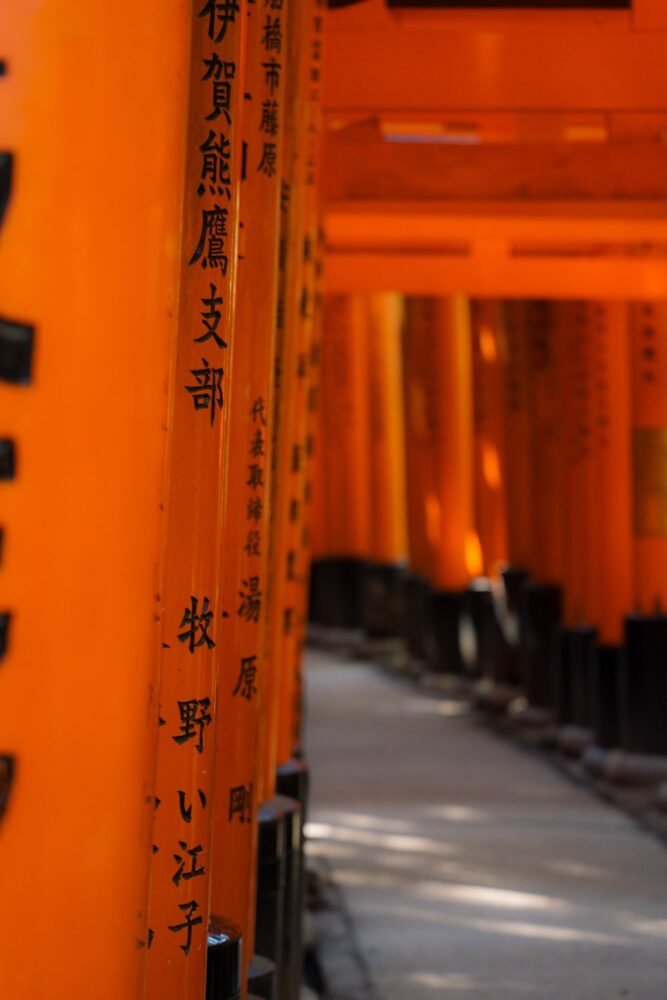
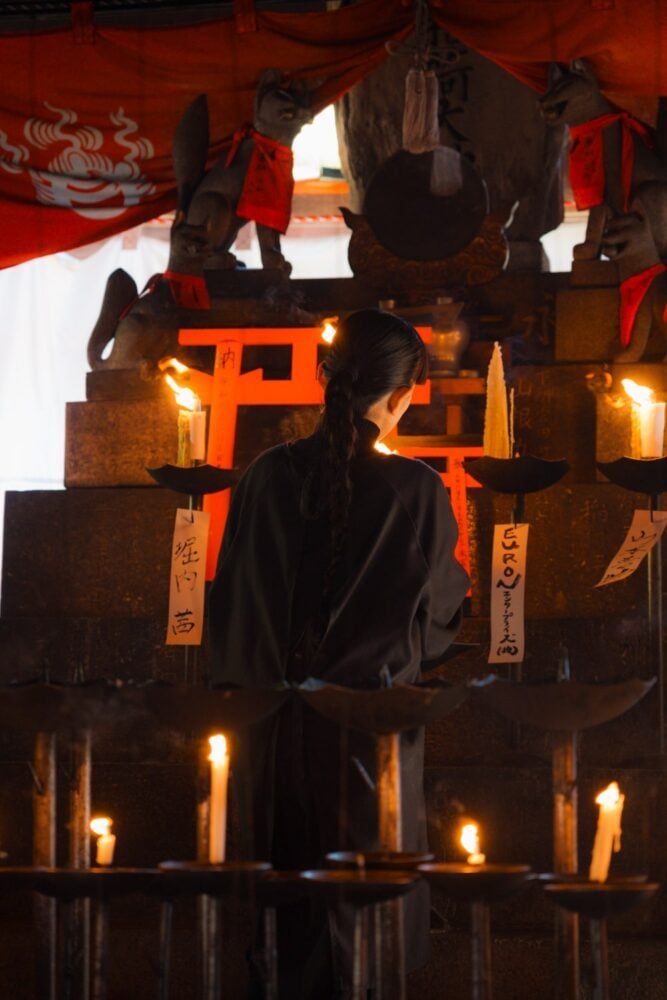

At each junction, take a right.
This will lead you up Mount Inari counterclockwise.
At the crossroads, take the right route up to the summit
The area where most tourists get lost and/or decide to head back down is at the Crossroads. This is where a few trail paths converge and diverge.
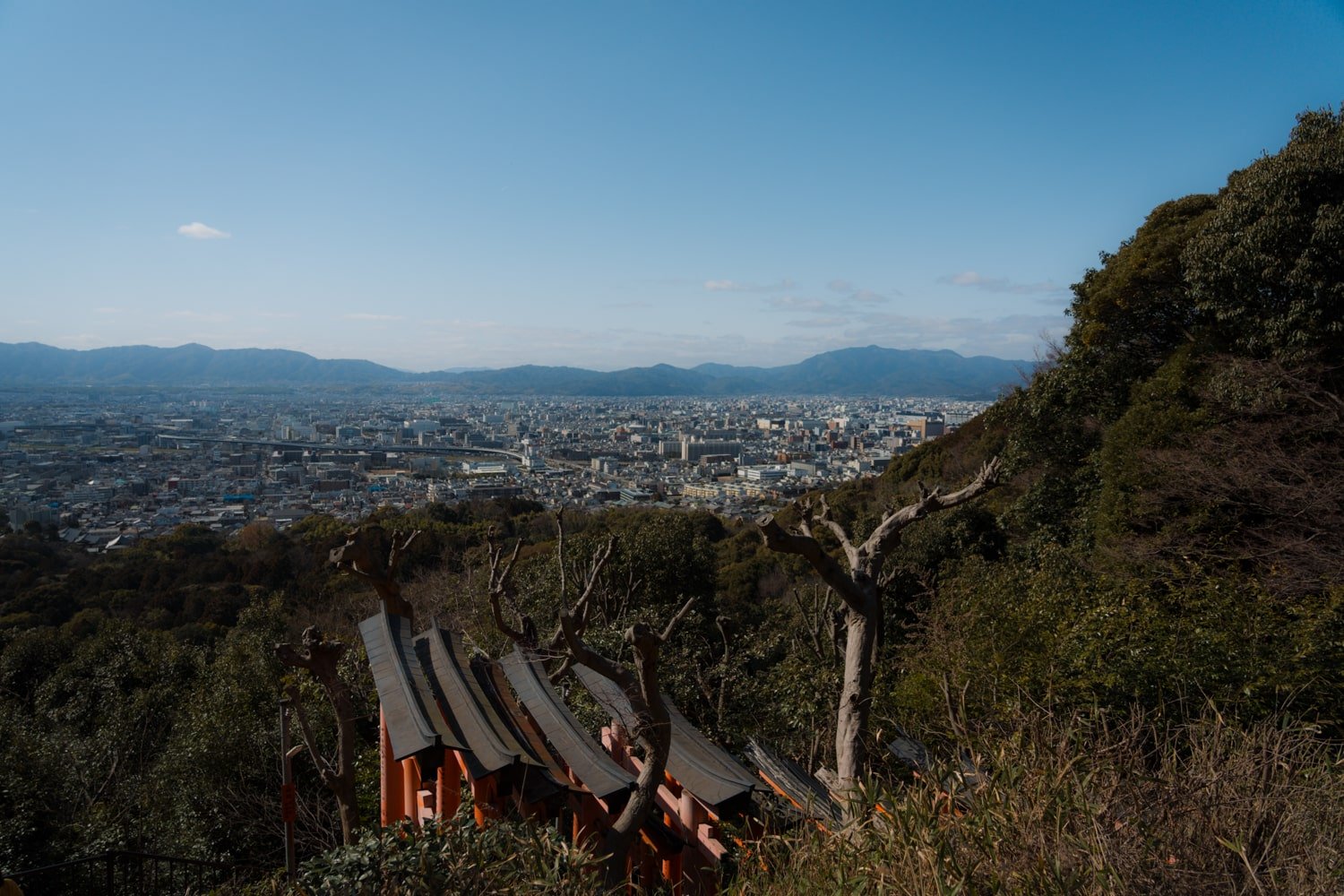
Many mistakenly think the stairs leading uphill, to their left, is the clockwise route up to Mount Inari. While that is true, it’s not the best route!
So instead of following the crowd, take a moment’s rest (and maybe some soybean ice cream🍦), and begin your easy climb up to Mount Inari by following the right (counterclockwise) route.
⚠️ If you take the left route (the stairs going down from the crossroads), you will still reach the summit of Mt Inari. But… beware of the brutal, near-endless set of stairs you’ll face soon after. Going in this direction made for a much more pleasant (and easy-paced) hiking experience.
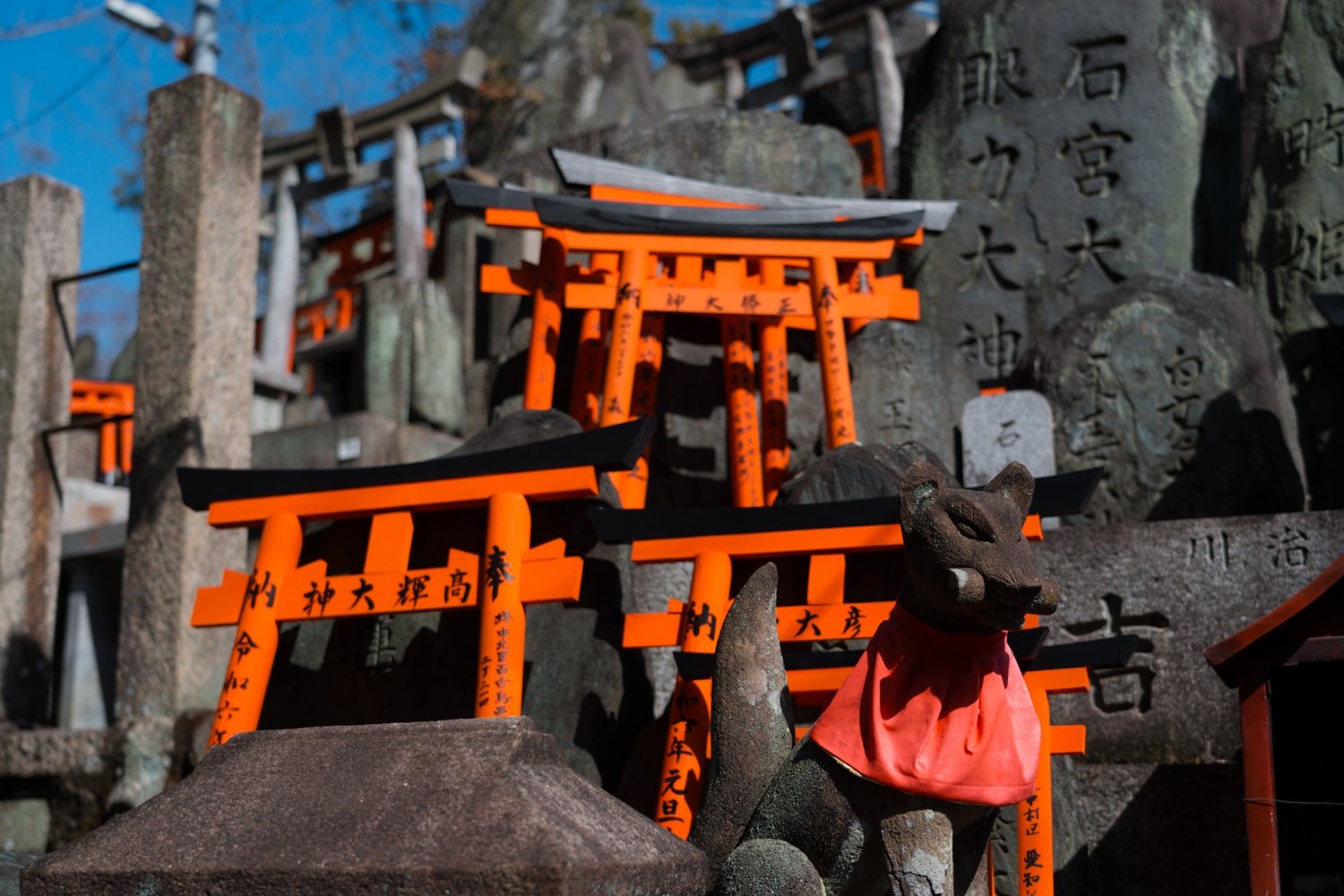
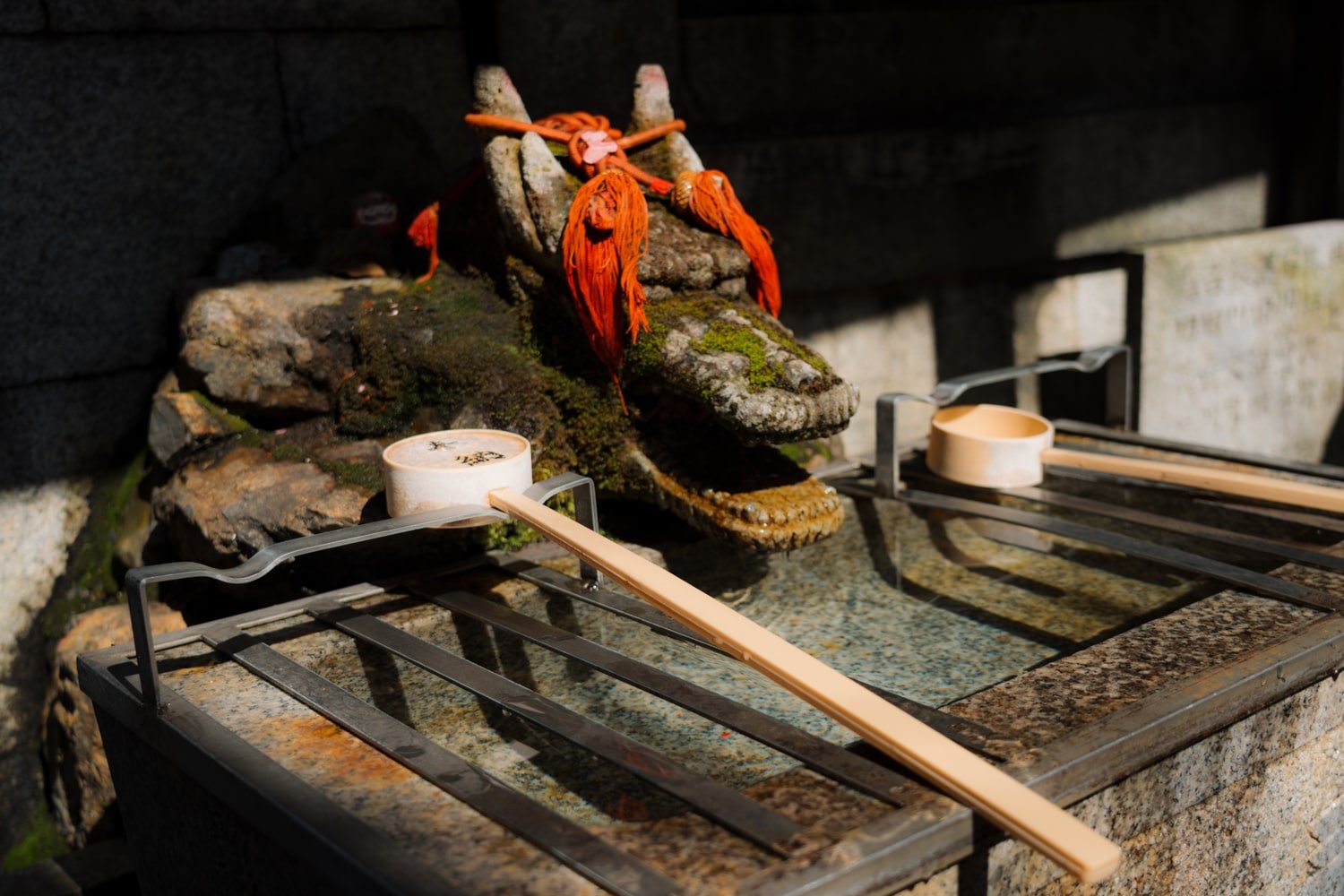
If you choose the right route toward “Shimosha,” your ascent is much more gradual.
Going up the mountain on the right side is a much more rewarding route than slowly heading back down on the other side.
Not only is it a better (easier) route on the body, but it’s also better for the light.
The morning-afternoon light shines in on the right route—thus bathing the forest and Torii gates in a pretty light.
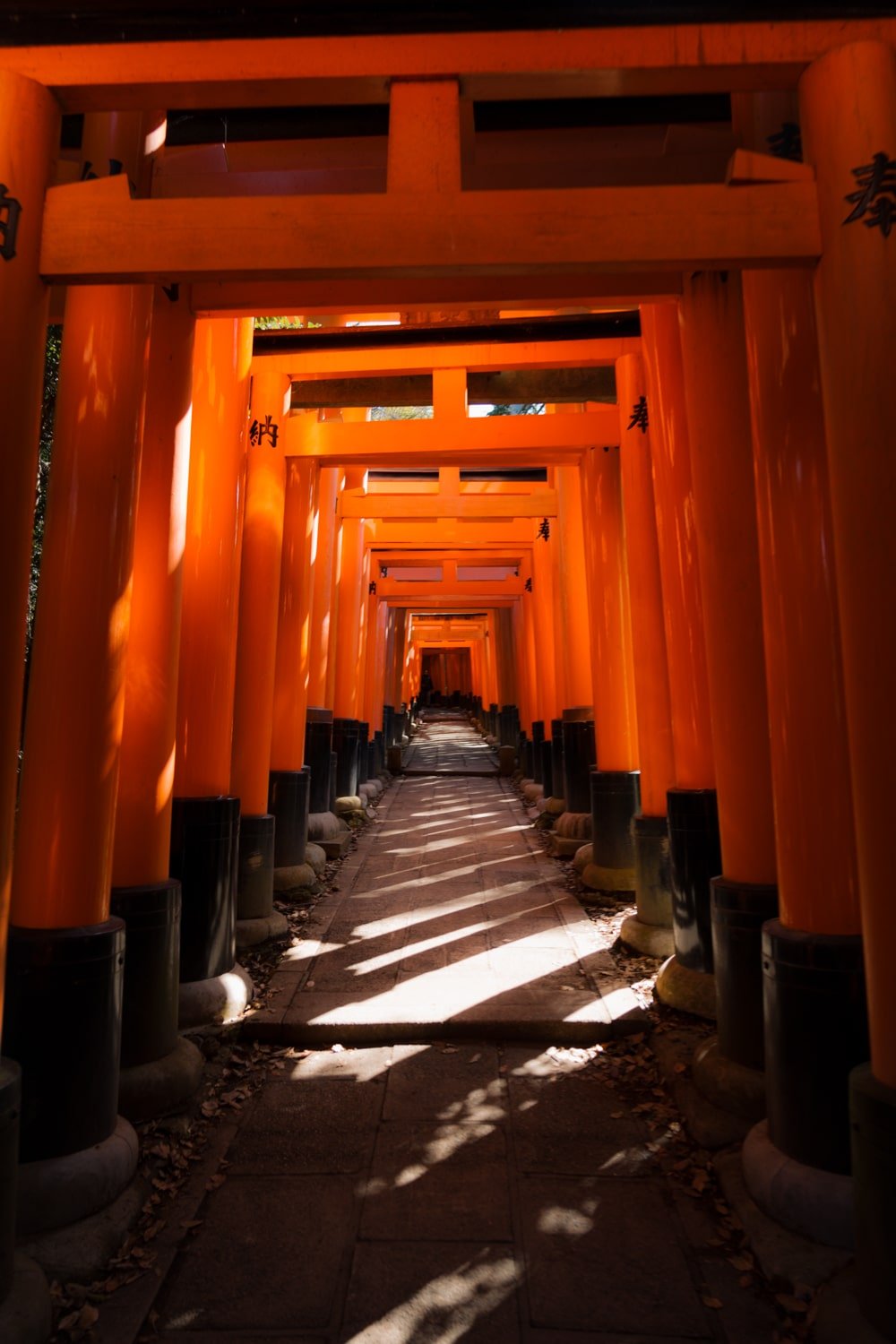
The left route (the way I came down from the summit) is much shadier, cooler, and less photogenic if it’s mostly the atmosphere/torii gates you want to follow.
The map will say the loop takes 30 minutes, but it’s probably double that for most hikers (30 minutes up, 25ish down, depending on your pace and how many photos you take!).
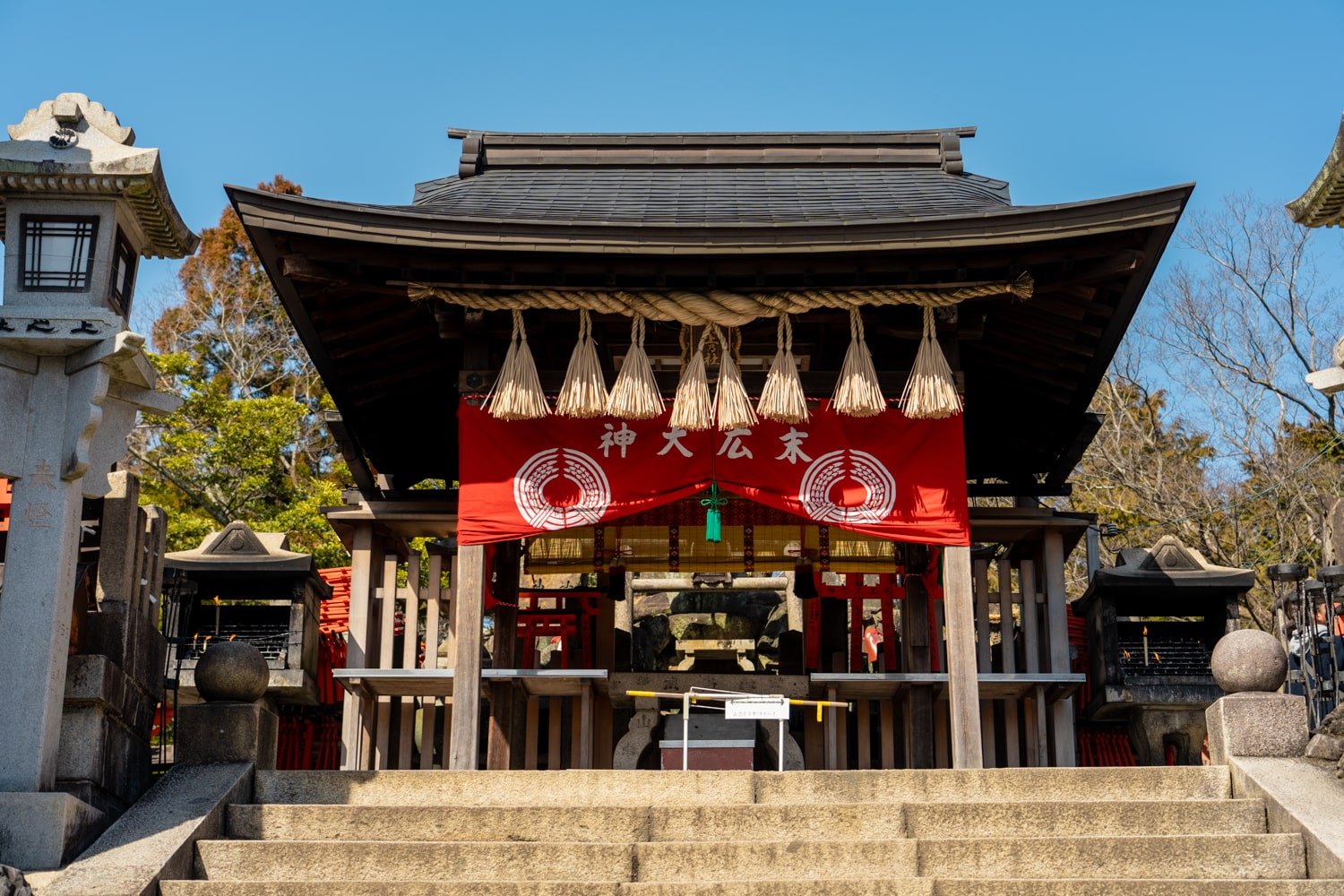
On your way down, you’ll pass several more rest stops where you can buy shrine souvenirs and take a rest.
Take a few moments to honor Inari Okami near the end of the loop at the prayer area for Mt. Inari (before you reach the crossroads again—or at the beginning if you follow the path clockwise).
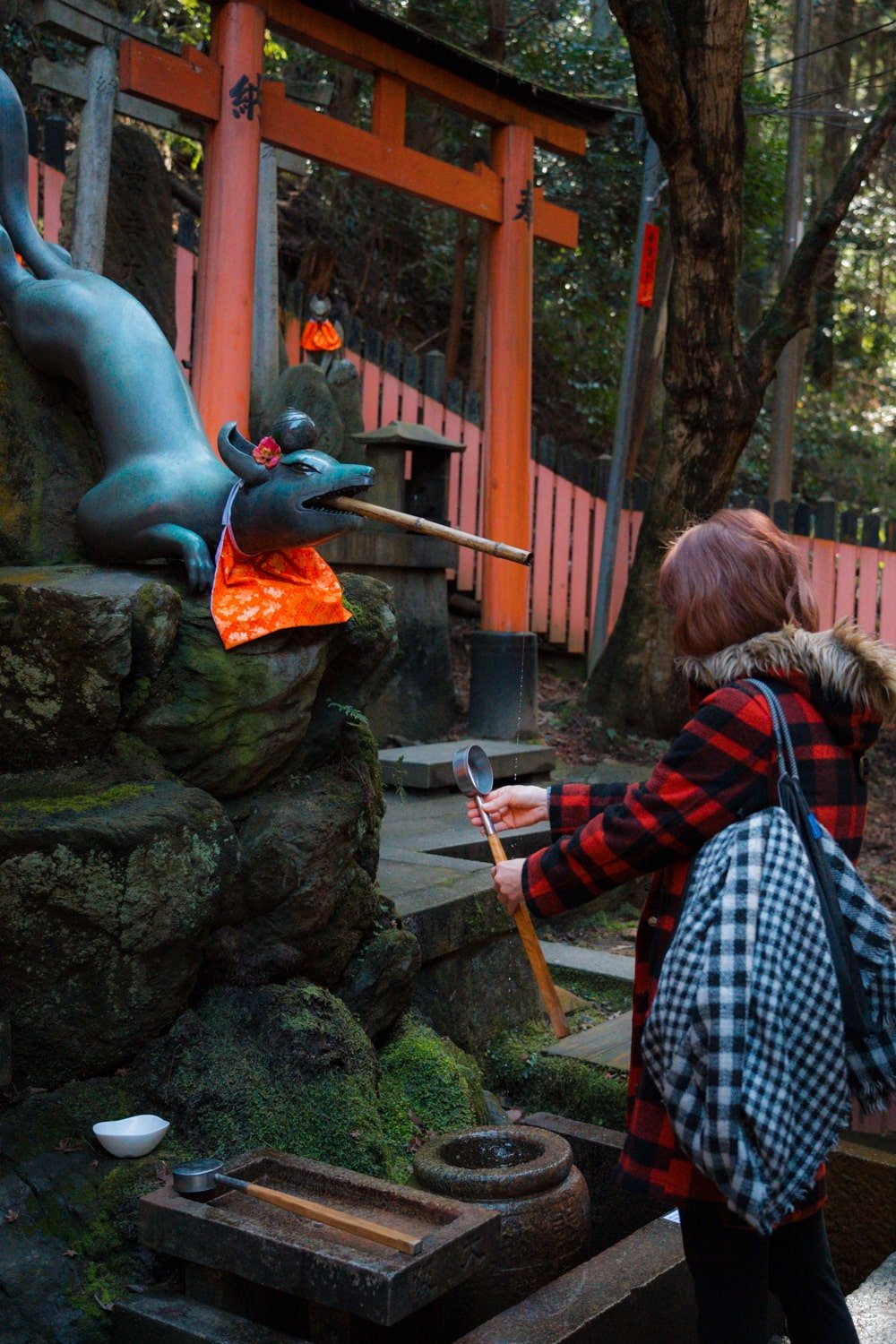
What Else to Do and See at Fushimi Inari
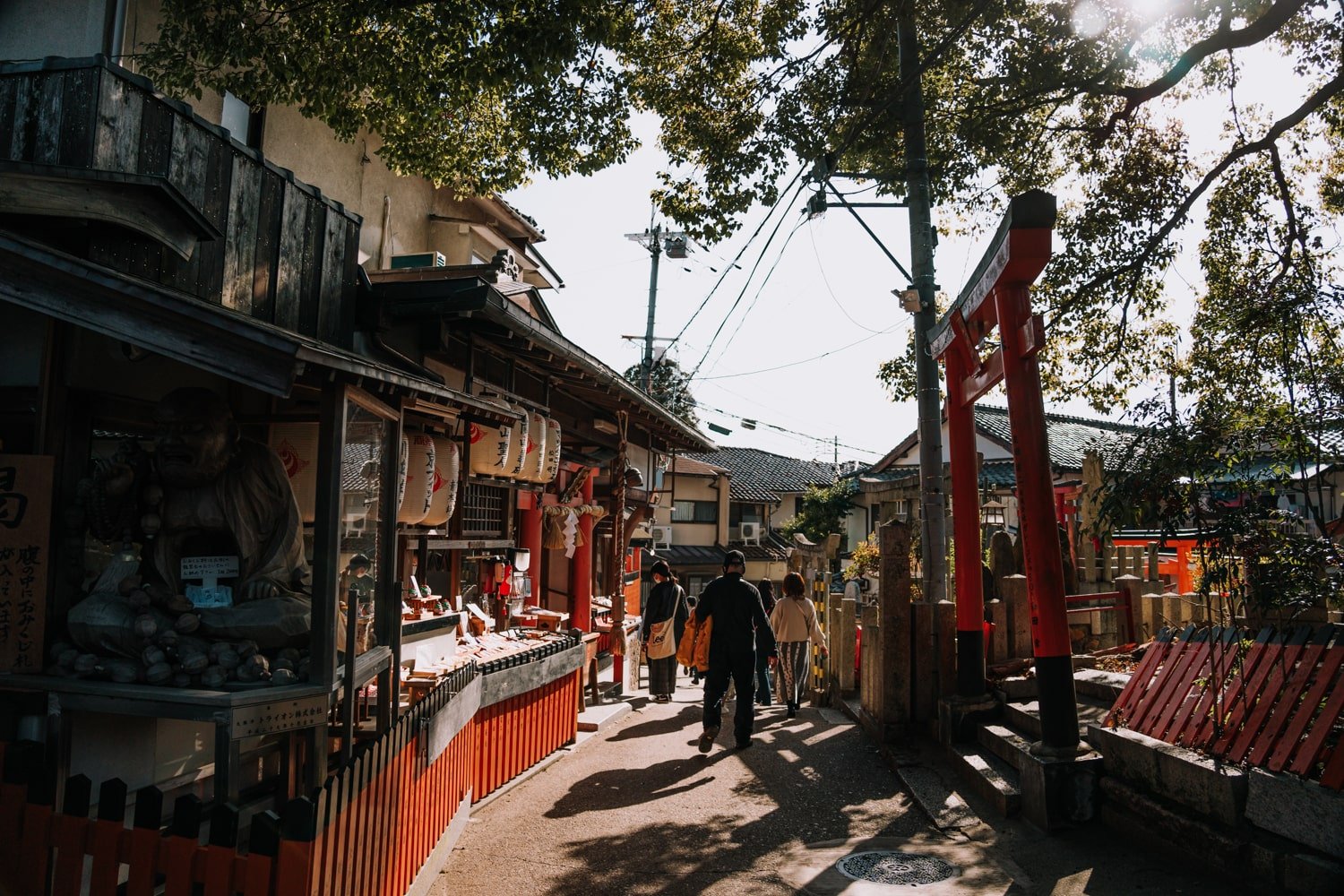
As you head down Mt. Inari and back to the station, don’t miss out on these fun side quests!
- Eat Inari Sushi – the foxes’ favorite food!
- Donate to support the Fushimi Inari cats.
- Try delicious amazake (fermented rice drink)!
- Purchase an omikuji souvenir.
- Dip inside the Fushimi Inari tea house.
- Grab a cup of organic coffee @ Pico Coffee!
🍙 Eat “Inari Sushi”
On your way down the mountain back to the shrine complex, you’ll see two little pop-up shops selling some snacks.
One particular snack is “Inari sushi,” vinegared rice wrapped in a thin layer of tofu skin (or yuba).
They say the Inari Okami loves tofu, so this little treat is especially necessary when visiting Fushimi Inari!
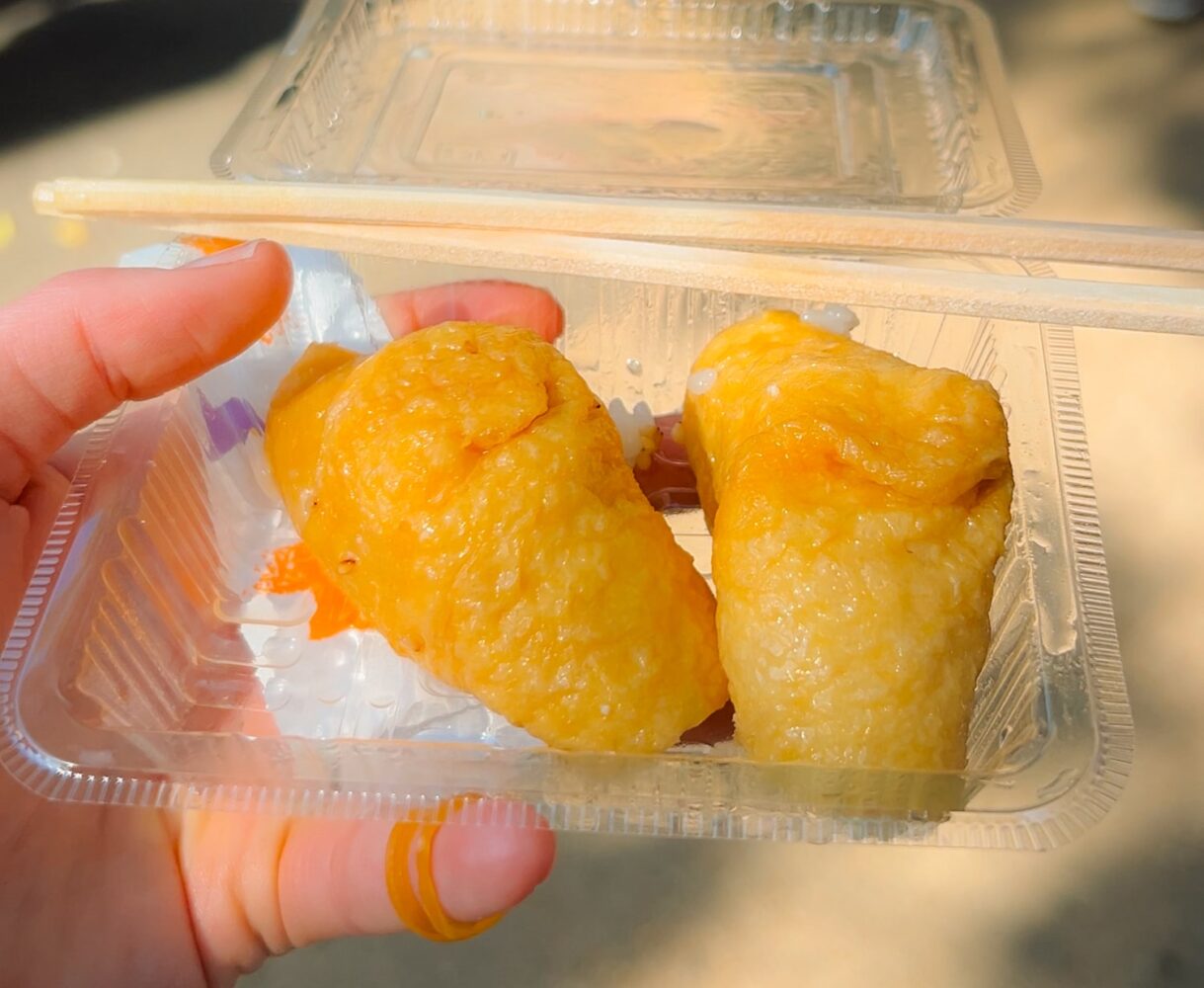
🐈 The Fushimi Inari cats
About two dozen cats are living on Mt. Inari!
As you pass by the last few stops on your way down, you’ll see donation boxes and tons of postcard photographs you can buy to support these sun-bathing felines.
🌾 Grab a cup of amazake!
Amazake is one of my favorite Japanese drinks, and you can find it right at the end of your hike at Fushimi Inari!
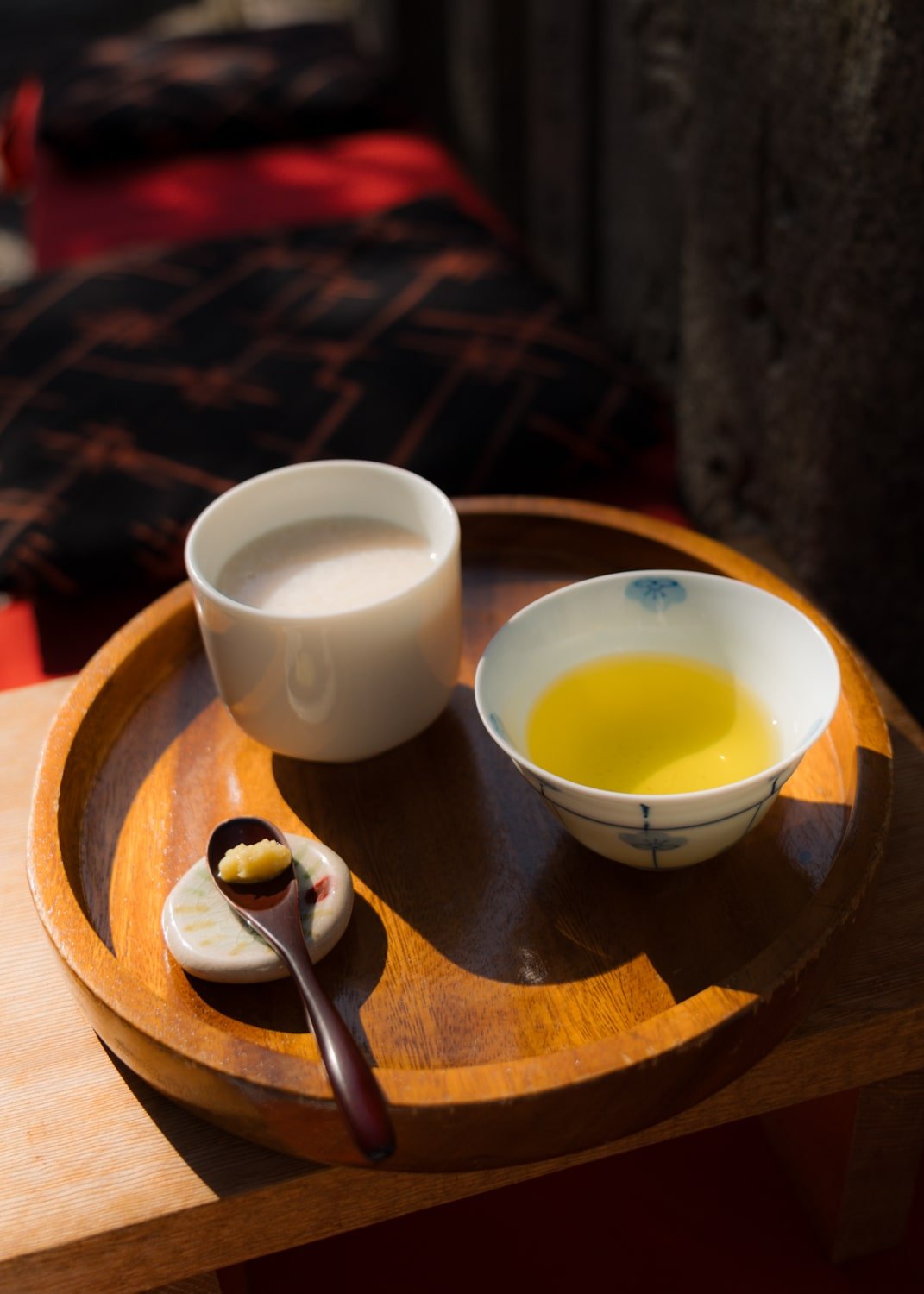
There’s a sweet elderly lady who sells it from her cute open-air cafe on a tiny, easy-to-miss side street. It’s called Amazake Suetomitei (あまざけ末富亭).
You can also find refreshments and tea at the shrine’s Sando Chaya Teahouse.
🦊 Take home an Inari souvenir
At most shrines and temples across Japan, you can purchase good luck charms and fortunes (omikuji). The ones at Fushimi Inari are, of course, fox-themed and make great gifts!
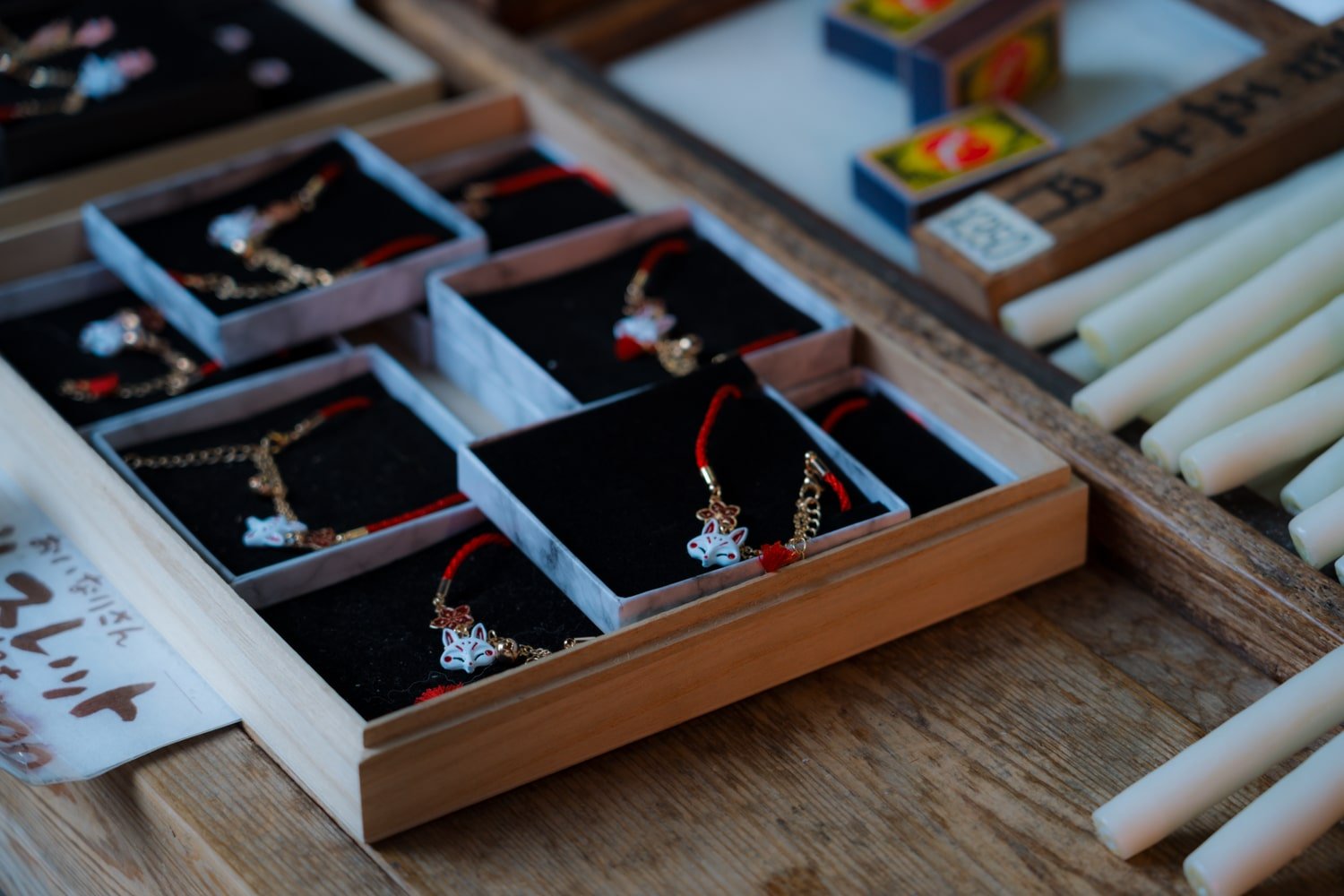
🍉 Grab a smoothie and a street snack and return to the Inari station!
As lunchtime nears, either stock up on the wide range of street snacks outside the shrine grounds or head downtown for lunch.
My final post-hike treat was a yuzu tea at Pico’s Coffee, plus a couple of Japanese street snack staples like fried sweet potato sticks and chicken yakitori!

Having visited the shrine AND summited Mt. Inari, I can’t believe I skipped out on it my first time in Kyoto. What a mistake!
Make sure to make the most of your morning by planning your mountainside exploration of Mt. Inari in advance. Remember to pack water for the trip and to respect nature and the thousands of torii gates!
I hope this guide helps you plan your hike to the Mt. Inari summit and soak up the mystical and sacred surrounding Fushimi Inari Shrine! 🦊 🤍


